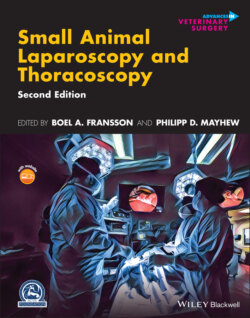Читать книгу Small Animal Laparoscopy and Thoracoscopy - Группа авторов - Страница 23
MIS Takes Off in Small Animal Surgery: The 2000s and Beyond
ОглавлениеArthroscopy was the first globally embraced veterinary MIS technique, but this text is mainly focusing on the soft tissue MIS division. Here, it would take another two decades before MIS would be more commonly used in small animal surgery. In 2009, the American College of Surgeons added a requirement for MIS in the resident training programs.
In 1999 Dr. Lynetta J. Freeman published “Veterinary Endosurgery,” the first textbook dedicated to application of MIS in small animals. At that time, few clinical procedures had been described in dogs or cats, and the editor and her colleagues (Figure 6) shared their extensive clinical research and training experience from the R & D section of Ethicon Endosurgery.
Dr. Clarence A. Rawlings (Figure 7) and coworkers presented a series of publications in the early 2000s, describing the use of different laparoscopic‐assisted surgical techniques. These continue to serve an important function today, bridging between open and laparoscopic surgery. Dr. Rawlings has also dedicated himself to MIS training of veterinarians.
Small animal MIS has benefitted from an important advocate in Dr. Eric Monnet over the last 25 years. His contributions to the field have been imperative to clinical adaptation and development of laparoscopic and thoracoscopic technique. In addition, Dr. Monnet's contributions also include founding the Veterinary Endoscopy Society (Figure 8) in 2003, bringing American veterinarians together with a common mission of promoting and developing minimally invasive techniques. Over the last several years, the VES has developed into a strong international coalition of MIS veterinary surgeons from several continents. Furthermore, Dr. Monnet spearheaded the formation of the ACVS Fellowship in MIS in 2017. Since then a number of institutions have initiated training of Fellows in this discipline, with Dr. Ingrid Balsa, UC Davis, becoming the first‐approved ACVS Fellow MIS Small Animal Soft Tissue Surgery, in 2020.
Development of increasingly advanced clinical techniques are currently ongoing at a fast pace, and important contributions over the last two decades have been made by Drs Gilles Dupre, Phil Mayhew, Brad Case, and Ameet Singh. Dr. Mayhew remains one of the most prolific and important contributors of scientific clinical work in the area of small animal MIS.
Figure 6 Drs. Lynnetta J. Freeman and Ronald J. Kolata are performing laparoscopy on a lion at the Audubon Zoo.
Source: Courtesy of Dr. Lynneta J. Freeman.
Figure 7 Dr. Clarence Rawlings.
Source: Courtesy of Dr. Clarence A. Rawlings.
Figure 8 The Veterinary Endoscopy Society was founded by Dr. Eric Monnet in 2003.
Lack of skills was noted as an important impediment to MIS development among our predecessors in the human field. Our research group has made some of our contributions to the veterinary MIS field within the area of assessment and training of veterinarians' manual skills. Parts of this work led to the Veterinary Assessment of Laparoscopic Skills program, a veterinary manual skills training program launched 2017. A number of institutions have subsequently contributed with significant developments within this area.
